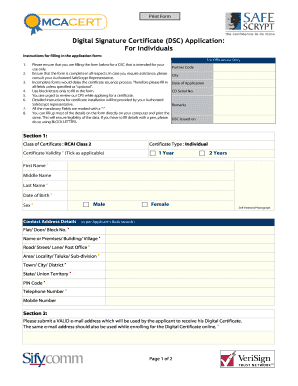Applying for a Digital Signature Certificate (DSC) on a PDF may seem like a straightforward process, yet it often presents numerous complexities and potential pitfalls. In a digital age where online transactions and agreements are paramount, understanding how to procure and utilize a DSC can significantly impact how effectively one can navigate the electronic landscape. Have you ever encountered a situation where you needed to sign a document electronically but felt daunted by the steps involved? Let’s unravel the intricacies of applying for a Digital Signature Certificate and address some common challenges faced during this process.
A Digital Signature Certificate is essential for ensuring authenticity and integrity in electronic documents. It serves as a form of identity verification in the digital realm. Before embarking on the journey to acquire a DSC, it is imperative to comprehend the prerequisites and the underlying technology that facilitates its operation. Simply put, a DSC utilizes cryptographic techniques to secure the signatory’s identity, allowing one to assert ownership over digital communications.
First and foremost, one must determine the type of Digital Signature Certificate needed. Generally, there are three categories: Class 1, Class 2, and Class 3 certificates. Class 1 certificates authenticate email identities and are most suitable for an individual, while Class 2 is often utilized by individuals and businesses for filing income tax returns or e-commerce transactions. Class 3 certificates are the most robust, used for online tenders and high-security applications. By identifying the appropriate class, applicants can proceed with the next steps with clarity.
The application process for a DSC typically involves several stages, beginning with selecting a Certifying Authority (CA). CAs are entities that validate the identity of the certifying applicant. They are entrusted with issuing digital certificates after thorough verification. Numerous CAs operate globally, each reflecting varying credibility and service quality. Investigating their reputations is crucial; after all, trust should be at the core of any digital transaction.
Once a suitable CA has been chosen, the next step is to gather the requisite documentation. Most CAs will request identification proof, such as a passport, driver’s license, or Aadhaar card. Additionally, proof of address and a passport-sized photograph may be necessary, depending on the jurisdiction and CA standards. Have you pondered their importance? These documents allow the CA to meticulously verify your identity to prevent potential fraud, ensuring that the certificate is issued to the rightful owner.
After compiling the necessary documents, applicants can commence the online application process through the CA’s website. Filling out the application form accurately is of the essence. Oftentimes, even a minor error can lead to delays or outright rejection of the application. Review each section meticulously, ensuring that names, addresses, and other details are consistent across documents.
Subsequently, applicants will upload their compiled documents on the CA’s portal. It’s critical to follow the specific formats and guidelines the CA outlines for document submissions. In many instances, digital copies must meet certain size restrictions and file types. A small oversight here can result in logistical setbacks. Are you beginning to see the delicate dance involved in this seemingly simple task?
Upon completion of the submission, applicants must await a verification process. This may involve the CA reaching out either via call or email to confirm the details provided. Consequently, maintaining updated contact information is vital during this phase. An applicant’s diligence can significantly influence the speed and efficiency of the DSC issuance process.
Once the CA verifies identity and documents, the Digital Signature Certificate is generated. This certificate is typically available in a .pfx or .p12 file format, which includes a public-private key pair. The private key allows the individual to sign documents, while the public key is used to verify the signature’s authenticity. To utilize the DSC effectively, it must be installed correctly on the user’s device, often through a specific cryptographic software that aligns with the operating system in use.
Challenges may arise even after obtaining the DSC. For instance, users must ensure their software supports DSC for signatories. Common software and applications have varying compatibility with different DSC formats. It is prudent to use secure software solutions to avoid exposing sensitive data to potential breaches. Moreover, periodic renewal of such certificates is necessary. Digital certificates usually hold specific validity periods (often one to three years), requiring proactive monitoring.
In conclusion, the application process for obtaining a Digital Signature Certificate on a PDF encompasses numerous steps, each demanding meticulous attention. By understanding the various intricacies involved—from selecting a reliable Certifying Authority to ensuring proper document submission—individuals can simplify what, at first glance, might appear an essentially daunting task. Are you prepared to tackle the challenges of the digital signature world?








Leave a Comment